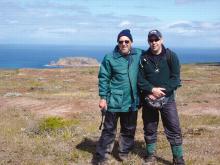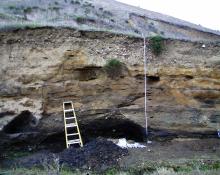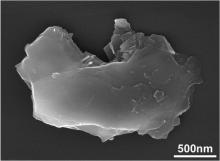


Nanosized diamonds found just a few meters below the surface of Santa Rosa Island off the coast of Santa Barbara provide strong evidence of a cosmic impact event in North America approximately 12,900 years ago, according to a new study by scientists. Their hypothesis holds that fragments of a comet struck across North America at that time.
The research, published this week in the Proceedings of the National Academy of Sciences (PNAS), was led by James Kennett, professor emeritus at UC Santa Barbara, and Douglas J. Kennett, first author, of the University of Oregon. The two are a father-son team. They were joined by 15 other researchers.
"The pygmy mammoth, the tiny island version of the North American mammoth, died off at this time," said James Kennett. "Since it coincides with this event, we suggest it is related." He explained that this site, with its layer containing hexagonal diamonds, is also associated with other types of diamonds and with dramatic environmental changes and wildfires. They are part of a sedimentary layer known as the Younger Dryas Boundary.
"There was a major event 12,900 years ago," said James Kennett. "It is hard to explain this assemblage of materials without a cosmic impact event and associated extensive wildfires. This hypothesis fits with the abrupt climatic cooling as recorded in ocean-drilled sediments beneath the Santa Barbara Channel. The cooling resulted when dust from the high-pressure, high-temperature, multiple impacts was lofted into the atmosphere, causing a dramatic drop in solar radiation."
The tiny diamonds were buried below four meters of sediment and they correspond with the disappearance of the Clovis culture –– the first well-established and distributed North American peoples. An estimated 35 types of mammals and 19 types of birds also became extinct in North America about this time.
"The type of diamond we have found –– lonsdaleite –– is a shock-synthesized mineral defined by its hexagonal crystalline structure," said Douglas Kennett, associate professor of anthropology at the University of Oregon. "It forms under very high temperatures and pressures consistent with a cosmic impact. These diamonds have only been found thus far in meteorites and impact craters on earth, and appear to be the strongest indicator yet of a significant cosmic impact [during Clovis]."
The diamonds were found in association with soot, which forms in extremely hot fires, and they suggest associated regional wildfires, based on nearby environmental records. Such soot and diamonds are rare in the geological record. They were found in sediment dating to massive asteroid impacts 65 million years ago in a layer widely known as the K-T Boundary, known to be associated with the extinction of dinosaurs and many other types of organisms.
James Kennett, former director of the Marine Science Institute at UCSB, is considered by some of his peers to be the "father" of marine geology and paleoceanography. The native of New Zealand notes that the sedimentary layers beneath the Santa Barbara Channel provide a unique window on the history of the world's climate and ocean changes. The area is one of the best locations in the world for this type of geological research.
Douglas Kennett received his bachelor's, master's, and Ph.D in anthropology at UCSB.
Co-authors on the PNAS paper are Jon M. Erlandson and Brendan J. Culleton, of the University of Oregon; Allen West of GeoScience Consulting in Arizona; G. James West of UC Davis; Ted E. Bunch and James H. Wittke, of Northern Arizona University; Shane S. Que Hee of UCLA; John R. Johnson of the Santa Barbara Museum of Natural History; Chris Mercer of UCSB and National Institute of Materials Science in Japan; Feng Shen of the FEI Company; Thomas W. Stafford of Stafford Research Inc. of Colorado; Wendy S. Wolbach and Adrienne Stich, of DePaul University in Chicago; and James C. Weaver of UC Riverside.
The National Science Foundation provided primary funding for this research.
Related Links



